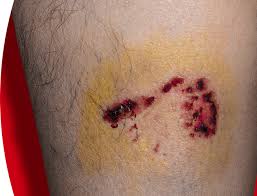How much harm can Leprosy cause to our body?
What is Leprosy?
The infectious disease leprosy results in severe, disfiguring skin lesions as well as nerve damage in the arms, legs, and other skin-covered parts of the body. Leprosy has existed since antiquity. People have been impacted by outbreaks on every continent.

Leprosy, however, is not very contagious. Only close and repeated contact with mouth and nose droplets from a person who has untreated leprosy will cause you to contract it. Leprosy affects children more frequently than it does adults.
According to the World Health Organization, there are currently roughly 208,000 leprosy cases globally, with the majority occurring in Africa and Asia. Leprosy is diagnosed in about 100 Americans annually, predominantly in the South, California, Hawaii, and a few U.S. territories.
How does Hansen’s disease spread?
Mycobacterium leprae is the culprit behind Hansen’s illness. It is believed that Hansen’s disease spreads by contact with an infected person’s mucosal secretions. When a person with Hansen’s disease sneezes or coughs, this typically happens.
The illness is not very communicable. On the other hand, prolonged close contact with an untreated person can cause Hansen’s disease to develop.
The bacteria that causes Hansen’s illness grows very slowly. According to the World Health Organization, the disease has an average incubation period of five years (the interval between infection and the onset of the first symptoms) .
It could take up to 20 years before symptoms start to show. The disease can also be carried by and passed on to people by armadillos, which are native to the southern United States and Mexico, according to the New England Journal of Medicine.
What are the symptoms of leprosy?
The following are the top three signs of leprosy (Hansen’s disease):
- Patches of skin that may be red or have lost their colour.
- Patches of skin without or with decreased sensation.
- Your hands, feet, arms, and legs may feel numb or tingly.
- burns or wounds that cause no pain on the hands and feet.
- muscle sluggishness
Leprosy (Hansen’s disease) patients may also experience:
- stiff or thick skin.
- periphery nerves that are larger.
- loss of eyebrows or eyelashes
- nasal blockage
- Nosebleeds.
When the illness is advanced, it may result in:
- Paralysis.
- loss of vision
- alteration to the nose.
- Injury to the hands and feet that is permanent.
- the fingers and toes become shorter.
- ulcers on the bottom of the feet that are chronic and don’t heal.
After contracting the Mycobacterium leprae infection, leprosy symptoms take between three and five years to manifest. It may potentially take up to two decades in rare circumstances. It is challenging for medical professionals to pinpoint the time and location of the infection because of this.
What causes Leprosy?
A form of bacteria called Mycobacterium leprae, which grows slowly, is the culprit behind leprosy (M. leprae). Another name for leprosy is Hansen’s disease, Hansen being the name of the researcher who discovered M. leprae in 1873.
It is unclear how leprosy is spread exactly. When a person with leprosy coughs or sneezes, they may release droplets that another person can breathe in that contain the M. leprae germs. Leprosy is spread by close personal contact with an afflicted person. It cannot be passed on through innocuous interactions such as handshakes, hugs, or sitting next to an infected person on a bus or at a table while eating.
Leprosy cannot be transmitted from pregnant women to their unborn children. Additionally, it cannot be spread through sexual contact.
How is Hansen’s disease diagnosed?
For the purpose of spotting early disease indicators, your doctor will do a physical examination. Additionally, they’ll perform a biopsy in which they take a tiny fragment of skin or nerve and send it to a lab for analysis.
The type of Hansen’s disease may potentially be identified by a lepromin skin test administered by your doctor. A tiny amount of the inactivated Hansen’s disease-causing bacterium will be injected beneath the skin, often on the upper forearm.
A beneficial outcome at the injection site will be felt by those who have tuberculoid or borderline tuberculoid Hansen’s illness.
How is Hansen’s disease treated?
In order to treat all forms of Hansen’s disease, the WHO created a multidrug therapy in 1995. It is accessible anywhere without cost.
Furthermore, a number of antibiotics work to treat Hansen’s illness by eradicating the bacterium that causes it. These antibiotics consist of:
- dapsone (Aczone)
- rifampin (Rifadin)
- clofazimine (Lamprene)
- minocycline (Minocin)
- ofloxacin (Ocuflux)
More than one antibiotic will probably be prescribed by your doctor concurrently.
They might also recommend that you take an anti-inflammatory drug such thalidomide, prednisone, or aspirin (Bayer, Rayos, and Rayos) (Thalomid). The course of treatment could extend for one to two years, or for many months.
If you are or may become pregnant, you should never take thalidomide. Serious birth abnormalities may result from it.
REFERENCES:
- https://www.healthline.com/health/leprosy
- https://www.webmd.com/skin-problems-and-treatments/guide/leprosy-symptoms-treatments-history
- https://my.clevelandclinic.org/health/diseases/23043-leprosy-hansens-disease
- https://www.cdc.gov/leprosy/treatment/index.html
For more details, kindly visit below.


